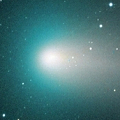
|
It brightened up to 6.8 mag in September (Sept. 17, Seiichi Yoshida). Now it is fading. It has already faded down to 10.0 mag (Oct. 16, Juan Jose Gonzalez). It is observable in excellent condition in the Southern Hemisphere. It will be getting lower gradually in the Northern Hemisphere.
Date(TT) R.A. (2000) Decl. Delta r Elong. m1 Best Time(A, h)
Oct. 20 7 19.00 -19 53.4 0.577 1.159 90 8.6 4:45 (348, 34)
Oct. 27 7 23.72 -25 0.5 0.626 1.208 93 9.0 4:51 (357, 30)
|
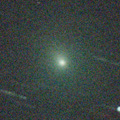
|
Now it is bright as 9.6 mag (Oct. 16, Juan Jose Gonzalez). It will approach to Earth down to 0.08 a.u. in December, and it is expected to brighten up to 3 mag. In the Northern Hemisphere, it stays observable in excellent condition. In the Southern Hemisphere, it is observable in good condition until mid December when it brightens up to 3 mag. But it becomes unobservable after that.
Date(TT) R.A. (2000) Decl. Delta r Elong. m1 Best Time(A, h)
Oct. 20 1 58.36 -31 19.6 0.345 1.274 138 9.3 0:06 ( 0, 24)
Oct. 27 1 59.15 -32 32.3 0.303 1.226 134 8.6 23:36 ( 0, 22)
|
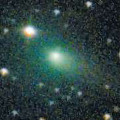
|
Now it is bright as 10.3 mag (Oct. 16, Maik Meyer). It will brighten up to 9 mag until winter. In the Northern Hemisphere, it stays observable in good condition for a long time until it fades out. In the Southern Hemispehre, it is observable in good condition until autumn, but it will be low in winter.
Date(TT) R.A. (2000) Decl. Delta r Elong. m1 Best Time(A, h)
Oct. 20 6 42.25 15 41.0 1.025 1.613 105 9.7 4:45 (357, 71)
Oct. 27 6 58.83 17 19.9 0.970 1.600 109 9.5 4:38 ( 0, 72)
|

|
It brightened up to 7.7 mag in June (June 19, Juan Jose Gonzalez). Now it is fading. But it is still bright as 10.3 mag (Oct. 12, Marco Goiato). It stays bright as 9-10 mag for a while. In the Southern Hemisphere, it stays observable in good condition for a long time until the comet will fade out. In the Northern Hemisphere, it is not observable for a long time until autumn in 2019 when the comet fades out down to 16 mag.
Date(TT) R.A. (2000) Decl. Delta r Elong. m1 Best Time(A, h)
Oct. 20 14 38.94 -65 27.7 2.757 2.356 56 10.3 18:43 ( 29,-31)
Oct. 27 14 45.44 -67 3.1 2.813 2.384 54 10.4 18:36 ( 27,-33)
|
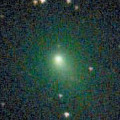
|
Now it is very bright as 10.4 mag (Oct. 15, Maik Meyer). It is observable in excellent condition in the Northern Hemisphere. It stays low in the Southern Hemisphere.
Date(TT) R.A. (2000) Decl. Delta r Elong. m1 Best Time(A, h)
Oct. 20 0 36.62 35 49.4 0.449 1.405 150 10.7 22:42 (180, 89)
Oct. 27 0 42.39 36 35.8 0.445 1.396 149 10.6 22:20 (180, 88)
|
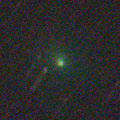
|
Now it is very bright as 10.8 mag (Oct. 12, Paul Camilleri). It stays at 10-11 mag until winter. It will be unobservable soon in the Southern Hemisphere. In the Northern Hemisphere, it stays observable for a long time until it fades out. But it stays extremely low.
Date(TT) R.A. (2000) Decl. Delta r Elong. m1 Best Time(A, h)
Oct. 20 15 56.37 -0 34.8 2.515 1.804 35 11.4 18:43 ( 78, 16)
Oct. 27 16 10.13 0 48.6 2.512 1.777 34 11.2 18:36 ( 80, 15)
|
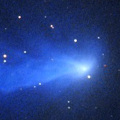
|
Now it is 10.7 mag (Oct. 16, Juan Jose Gonzalez). It will be fading slowly after this. In the Northern Hemisphere, it stays low until October. But it will be observable in good condition after that. In the Southern Hemisphere, it is not observable until summer in 2019.
Date(TT) R.A. (2000) Decl. Delta r Elong. m1 Best Time(A, h)
Oct. 20 13 10.31 44 52.8 3.570 3.114 55 12.2 4:45 (228, 19)
Oct. 27 13 26.39 44 3.9 3.577 3.154 57 12.3 4:51 (230, 21)
|

|
Now it is 12.2 mag (Oct. 6, Paul Camilleri). It stays 12 mag for a long time until spring.
Date(TT) R.A. (2000) Decl. Delta r Elong. m1 Best Time(A, h)
Oct. 20 8 59.42 6 10.2 3.005 2.844 71 12.2 4:45 (303, 46)
Oct. 27 8 57.04 3 56.1 2.906 2.870 78 12.2 4:51 (316, 50)
|

|
It brightens up to 13 mag in October. But it is not observable at all.
Date(TT) R.A. (2000) Decl. Delta r Elong. m1 Best Time(A, h)
Oct. 20 14 35.77 -10 31.0 2.046 1.109 14 13.0 18:43 ( 81, -6)
Oct. 27 15 4.91 -11 12.4 2.063 1.132 14 13.1 18:36 ( 80, -5)
|
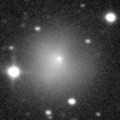
|
Now it is bright as 11.6 mag (Oct. 13, Maik Meyer).
Date(TT) R.A. (2000) Decl. Delta r Elong. m1 Best Time(A, h)
Oct. 20 22 46.77 -0 38.7 5.011 5.770 136 13.2 20:52 ( 0, 54)
Oct. 27 22 45.53 -0 48.5 5.093 5.770 128 13.2 20:23 ( 0, 54)
|
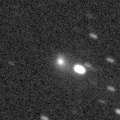
|
Now it is 13.5 mag (Oct. 11, Paul Camilleri). It stays at 12-13 mag for a long time until autumn in 2019.
Date(TT) R.A. (2000) Decl. Delta r Elong. m1 Best Time(A, h)
Oct. 20 21 23.22 -8 52.3 1.818 2.401 113 13.7 19:29 ( 0, 46)
Oct. 27 21 27.04 -9 1.7 1.872 2.373 107 13.6 19:05 ( 0, 46)
|
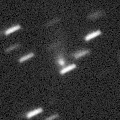
|
It brightened up to 8.7 mag in July (July 18, Marco Goiato). Then it faded down to 12.3 mag in August (Aug. 29, Chris Wyatt). Now it is not observable. It will appear in the morning sky in late December.
Date(TT) R.A. (2000) Decl. Delta r Elong. m1 Best Time(A, h)
Oct. 20 14 17.19 -26 38.0 2.705 1.793 18 13.7 18:43 ( 70,-19)
Oct. 27 14 31.40 -26 0.9 2.829 1.886 14 14.0 18:36 ( 71,-20)
|
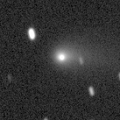
|
Now it is bright as 12.8 mag (Oct. 12, Paul Camilleri). It will be fading after this. It stays observable in excellent condition for a while in the Southern Hemisphere. It locates somewhat low in the Northern Hemisphere.
Date(TT) R.A. (2000) Decl. Delta r Elong. m1 Best Time(A, h)
Oct. 20 22 35.02 -27 5.9 1.368 2.077 122 13.8 20:40 ( 0, 28)
Oct. 27 22 39.84 -26 10.0 1.443 2.091 117 14.0 20:18 ( 0, 29)
|
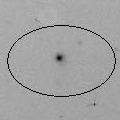
|
Now it is 13.7 mag (Oct. 11, Paul Camilleri). It will brighten up to 10-11 mag in autumn in 2019. It stays observable in good condition for a while in the Southern Hemisphere. In the Northern Hemisphere, it stays extremely low for a long time.
Date(TT) R.A. (2000) Decl. Delta r Elong. m1 Best Time(A, h)
Oct. 20 2 16.74 -47 6.7 4.164 4.768 122 13.9 0:25 ( 0, 8)
Oct. 27 2 6.57 -46 46.2 4.138 4.722 120 13.8 23:42 ( 0, 8)
|
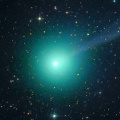
|
It brightened rapidly in outburst up to 6.9 mag (July 19, Maik Meyer). Then it faded down to 9.3 mag (Aug. 2, Katsumi Yoshimoto). It approached to Sun down to 0.2 a.u. in August, and it was expected to brighten up to 3 mag. However, it must have been already disintegrated. In the Northern Hemisphere, it is appearing in the morning sky. But it will be too faint to observe.
Date(TT) R.A. (2000) Decl. Delta r Elong. m1 Best Time(A, h)
Oct. 20 12 44.93 18 46.4 2.356 1.597 31 13.9 4:45 (254, 9)
Oct. 27 12 55.81 20 2.6 2.411 1.720 36 14.3 4:51 (255, 14)
|
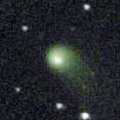
|
Now it is 14.0 mag (Oct. 7, Seiichi Yoshida). It stays 13-14 mag until summer in 2019. It will be unobservable soon in the Southern Hemisphere, or in November in the Northeren Hemisphere.
Date(TT) R.A. (2000) Decl. Delta r Elong. m1 Best Time(A, h)
Oct. 20 16 26.12 5 7.5 3.998 3.363 44 14.3 18:43 ( 78, 25)
Oct. 27 16 29.35 3 15.7 4.055 3.347 39 14.3 18:36 ( 79, 20)
|
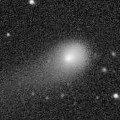
|
Now it is 14.3 mag (Aug. 17, Ken-ichi Kadota). It will be observable at 13-14 mag for a long time from 2017 to 2018. In the Southern Hemisphere, it will be hardly observable after this. In the Northern Hemispehre, it became low temporarily in September, but it will become high after this.
Date(TT) R.A. (2000) Decl. Delta r Elong. m1 Best Time(A, h)
Oct. 20 11 59.54 34 39.3 4.863 4.298 50 14.4 4:45 (245, 26)
Oct. 27 12 0.52 34 35.7 4.812 4.328 55 14.4 4:51 (248, 32)
|

|
Now it is 14.1 mag (Oct. 7, Seiichi Yoshida). It stays at 14 mag until winter. It is observable in excellent condition in the Northern Hemisphere. In the Southern Hemisphere, it is not observable until summer in 2019.
Date(TT) R.A. (2000) Decl. Delta r Elong. m1 Best Time(A, h)
Oct. 20 7 34.22 66 46.0 1.516 1.949 99 14.5 4:45 (190, 57)
Oct. 27 8 8.71 69 21.4 1.490 1.947 101 14.4 4:51 (189, 55)
|
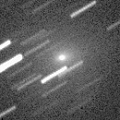
|
It approached to Earth down to 0.3 a.u., and brightened up to 8.3 mag in July (July 22, Juan Jose Gonzalez). Now it is fading. But it is still bright as 13.2 mag (Sept. 24, Thomas Lehmann). Now it is not observable. It will appear in the morning sky again in December in the Northern Hemisphere, or in January in the Southern Hemisphere.
Date(TT) R.A. (2000) Decl. Delta r Elong. m1 Best Time(A, h)
Oct. 20 15 11.72 -6 23.6 2.609 1.743 23 14.5 18:43 ( 80, 3)
Oct. 27 15 13.83 -6 7.9 2.724 1.808 18 14.7 18:36 ( 83, 0)
|

|
Now it is 18.4 mag (Sept. 17, iTelescope Observatory, Siding Spring). It locates low. But it brightens up to 14.5 mag from October to November.
Date(TT) R.A. (2000) Decl. Delta r Elong. m1 Best Time(A, h)
Oct. 20 16 20.71 -22 50.6 1.308 0.857 40 15.0 18:43 ( 56, 6)
Oct. 27 16 55.63 -24 41.3 1.244 0.838 42 14.7 18:36 ( 53, 7)
|

|
Now it is 14.5 mag (Aug. 16, P. Camilleri, H. Williams). It stays 15 mag from 2018 to 2019, and it will be observable for a long time in the Southern Hemisphere. In the Northern Hemisphere, it will never be observable again.
Date(TT) R.A. (2000) Decl. Delta r Elong. m1 Best Time(A, h)
Oct. 20 15 19.38 -67 53.2 4.429 4.027 60 15.0 18:43 ( 25,-28)
Oct. 27 15 43.03 -68 14.0 4.452 4.013 57 15.0 18:36 ( 24,-28)
|
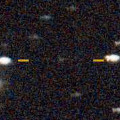
|
Now it is 16.9 mag (Oct. 1, Ken-ichi Kadota). It will brighten up to 13-14 mag in winter, and it will be observable in excellent condition. It locates low in the Southern Hemisphere.
Date(TT) R.A. (2000) Decl. Delta r Elong. m1 Best Time(A, h)
Oct. 20 9 25.29 29 1.2 2.385 2.288 72 15.9 4:45 (268, 54)
Oct. 27 9 39.46 28 40.5 2.293 2.268 76 15.7 4:51 (271, 58)
|
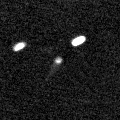
|
Now it is 15.8 mag (Oct. 6, Ken-ichi Kadota). It will brighten up to 15 mag in winter. It is observable in excellent condition in the Northern Hemisphere. It is not observable at all in the Southern Hemisphere.
Date(TT) R.A. (2000) Decl. Delta r Elong. m1 Best Time(A, h)
Oct. 20 11 11.32 40 59.2 3.738 3.373 61 16.1 4:45 (242, 37)
Oct. 27 11 14.25 42 26.4 3.612 3.358 67 16.1 4:51 (242, 43)
|
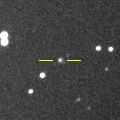
|
Now it is 16.7 mag (Oct. 11, Thomas Lehmann). It is expected to brighten up to 7-8 mag in 2020. In 2018, it will be observable at 15-16 mag in good condition from autum to winter.
Date(TT) R.A. (2000) Decl. Delta r Elong. m1 Best Time(A, h)
Oct. 20 3 51.16 -5 40.0 5.454 6.280 143 16.2 1:59 ( 0, 49)
Oct. 27 3 47.45 -5 50.2 5.353 6.221 148 16.1 1:28 ( 0, 49)
|

|
It brightened up to 7.1 mag from May to June in 2017 (June 21, Juan Jose Gonzalez). Now it is fading. It has already faded down to 16.6 mag (Sept. 3, Slooh.com Chile Observatory, La Dehesa). In the Southern Hemisphere, it stays observable for a long time after this. It will never be observable again in the Northern Hemisphere.
Date(TT) R.A. (2000) Decl. Delta r Elong. m1 Best Time(A, h)
Oct. 20 1 18.26 -54 33.8 5.201 5.696 115 16.4 23:22 ( 0, 1)
Oct. 27 1 12.15 -54 11.4 5.305 5.756 112 16.5 22:48 ( 0, 1)
|

|
Now it is 16.2 mag (Sept. 16, Mt. Lemmon Survey). It is observable in good condition in the Southern Hemisphere. It locates somewhat low in the Northern Hemisphere.
Date(TT) R.A. (2000) Decl. Delta r Elong. m1 Best Time(A, h)
Oct. 20 22 47.57 -19 43.8 2.681 3.393 128 16.5 20:52 ( 0, 35)
Oct. 27 22 46.88 -19 21.3 2.777 3.408 121 16.6 20:24 ( 0, 36)
|
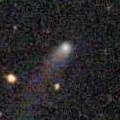
|
It brightened up to 14.7 mag in early 2018 (Jan. 25, Catalina Sky Survey). Now it is fading slowly. Now it is 16.5 mag (Sept. 16, Kunihiro Shima). In the Northern Hemisphere, it stays observable in good condition for a long time until the comet fades out. It is never observable again in the Southern Hemisphere.
Date(TT) R.A. (2000) Decl. Delta r Elong. m1 Best Time(A, h)
Oct. 20 8 24.90 59 12.2 5.729 5.862 92 16.5 4:45 (208, 60)
Oct. 27 8 23.71 60 38.3 5.653 5.884 98 16.5 4:51 (199, 62)
|
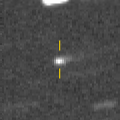
|
Now it is 16.0 mag (Oct. 6, Ken-ichi Kadota). It will brighten very rapidly after this. It will brighten up to 14.5 mag from January to February, and it is expected to be observable in excellent condition.
Date(TT) R.A. (2000) Decl. Delta r Elong. m1 Best Time(A, h)
Oct. 20 8 45.31 17 34.8 1.617 1.702 77 16.8 4:45 (293, 57)
Oct. 27 9 3.21 16 4.6 1.547 1.683 79 16.5 4:51 (300, 59)
|
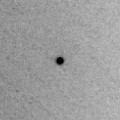
|
Now it is 16.2 mag (June 17, Jean-Francois Soulier). It stays 16 mag for a while. In the Northern Hemisphere, it stays observable in good condition after this until it fades out. It is not observable in the Southern Hemisphere. Its cometary activity was observed on Mar. 26 (M. Mommert, D. Polishook, N. Moskovitz).
Date(TT) R.A. (2000) Decl. Delta r Elong. m1 Best Time(A, h)
Oct. 20 1 54.42 54 36.6 1.475 2.293 135 16.6 0:04 (180, 70)
Oct. 27 1 39.29 54 32.6 1.518 2.351 137 16.6 23:15 (180, 70)
|
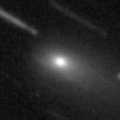
|
It brightened up to 12 mag from spring to summer. Now it is fading. It has already faded down to 17.1 mag (Oct. 8, Toshihiko Ikemura, Hirohisa Sato).
Date(TT) R.A. (2000) Decl. Delta r Elong. m1 Best Time(A, h)
Oct. 20 22 54.95 4 55.6 1.393 2.245 139 16.7 21:00 ( 0, 60)
Oct. 27 22 55.79 4 47.7 1.490 2.285 132 17.0 20:33 ( 0, 60)
|
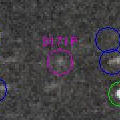
|
Now it is 19.7 mag (Sept. 18, R. Fichtl). It will brighten rapidly. It is expected to be observable at 15.5 mag in good condition in winter.
Date(TT) R.A. (2000) Decl. Delta r Elong. m1 Best Time(A, h)
Oct. 20 4 59.29 -7 38.8 1.165 1.933 126 17.0 3:07 ( 0, 47)
Oct. 27 5 1.05 -7 46.4 1.100 1.910 131 16.7 2:41 ( 0, 47)
|
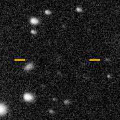
|
Now it is 17.1 mag (Sept. 16, Ken-ichi Kadota). It is observable at 16.5 mag in good condition from autumn to winter. It locates somewhat low in the Southern Hemisphere.
Date(TT) R.A. (2000) Decl. Delta r Elong. m1 Best Time(A, h)
Oct. 20 8 1.22 27 25.2 2.162 2.373 89 16.8 4:45 (287, 71)
Oct. 27 8 10.17 26 56.0 2.087 2.379 94 16.7 4:51 (298, 75)
|

|
Now it is 16.9 mag (Sept. 12, D. Buczynski). It stays 16-17 mag for a long time until 2020. It is observable in good condition in the Northern Hemisphere. It is not observable at all in the Southern Hemisphere.
Date(TT) R.A. (2000) Decl. Delta r Elong. m1 Best Time(A, h)
Oct. 20 10 57.10 67 36.8 8.546 8.480 82 16.8 4:45 (208, 42)
Oct. 27 11 5.83 67 47.4 8.479 8.477 86 16.8 4:51 (207, 44)
|
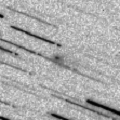
|
First return of a new periodic comet which brightened up to 17.5 mag in 2010. Now it is 18.1 mag (Sept. 9, Mt. Lemmon Survey). It is expected to brighten up to 16.5 mag from November to December. It is observable in excellent condition in the Northern Hemisphere. It locates low in the Southern Hemisphere.
Date(TT) R.A. (2000) Decl. Delta r Elong. m1 Best Time(A, h)
Oct. 20 5 58.20 27 33.9 1.297 1.958 116 17.0 4:06 ( 0, 83)
Oct. 27 6 4.95 28 35.9 1.243 1.960 122 16.9 3:45 ( 0, 84)
|
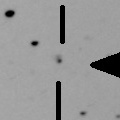
|
Asteroid, but it brightened rapidly. Now it is 16.8 mag (Aug. 16, Slooh.com Chile Observatory, La Dehesa).
Date(TT) R.A. (2000) Decl. Delta r Elong. m1 Best Time(A, h)
Oct. 20 22 39.94 -46 1.4 6.362 6.785 111 17.0 20:44 ( 0, 9)
Oct. 27 22 33.15 -45 42.8 6.447 6.770 104 17.0 20:10 ( 0, 9)
|
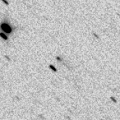
|
First return of a new periodic comet which brightened up to 16.5 mag in 2005. Now it is 17.3 mag (Sept. 15, A. Martin, K. Kleemann-Boeker). It will be observable at 17 mag in good condition in autumn. It locates low in the Southern Hemisphere.
Date(TT) R.A. (2000) Decl. Delta r Elong. m1 Best Time(A, h)
Oct. 20 1 54.72 33 50.7 1.146 2.095 155 17.0 0:03 ( 0, 89)
Oct. 27 1 52.39 32 38.0 1.146 2.107 159 17.0 23:29 ( 0, 88)
|
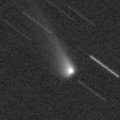
|
Now it is 16.4 mag (Sept. 18, ATLAS-MLO, Mauna Loa). Fading now. It stays observable in good condition for a long time after this in the Southern Hemisphere. It stays low in the Northern Hemisphere.
Date(TT) R.A. (2000) Decl. Delta r Elong. m1 Best Time(A, h)
Oct. 20 23 5.52 -39 6.6 4.388 4.954 119 17.1 21:10 ( 0, 16)
Oct. 27 22 57.89 -39 30.7 4.520 4.982 112 17.2 20:35 ( 0, 16)
|
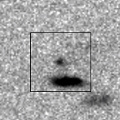
|
Now it is 18.0 mag (Sept. 10, iTelescope Observatory, Mayhill). It is observable at 17 mag in good condition in winter. It locates low in the Southern Hemisphere.
Date(TT) R.A. (2000) Decl. Delta r Elong. m1 Best Time(A, h)
Oct. 20 9 58.10 20 36.0 2.417 2.140 62 17.2 4:45 (275, 44)
Oct. 27 10 10.42 20 20.7 2.379 2.177 66 17.1 4:51 (278, 48)
|
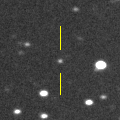
|
Now it is 16.6 mag (Oct. 7, Toshihiko Ikemura, Hirohisa Sato). It will be fading after this. It will be fainter than 18 mag in December.
Date(TT) R.A. (2000) Decl. Delta r Elong. m1 Best Time(A, h)
Oct. 20 21 33.37 -7 40.4 1.339 1.996 116 17.3 19:39 ( 0, 47)
Oct. 27 21 40.23 -7 34.0 1.388 1.980 111 17.4 19:18 ( 0, 48)
|

|
Now it is 16.8 mag (Sept. 14, A. Diepvens). It will be fading gradually after this, and it will be fainter than 18 mag in winter. In the Northern Hemisphere, it stays observable in good condition for a long time. In the Southern Hemisphere, it will never be observable again.
Date(TT) R.A. (2000) Decl. Delta r Elong. m1 Best Time(A, h)
Oct. 20 22 38.08 74 52.4 7.333 7.740 110 17.4 20:42 (180, 50)
Oct. 27 22 36.87 74 3.7 7.339 7.767 112 17.4 20:14 (180, 51)
|
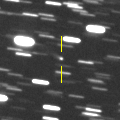
|
It was observed at 17 mag in last winter. It will be observable in good condition at 17.5 mag also in this winter.
Date(TT) R.A. (2000) Decl. Delta r Elong. m1 Best Time(A, h)
Oct. 20 5 37.27 8 38.9 7.441 7.998 120 17.4 3:45 ( 0, 64)
Oct. 27 5 33.43 8 11.0 7.348 8.004 128 17.4 3:14 ( 0, 63)
|
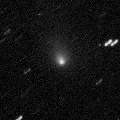
|
It brightened very rapidly up to 13.8 mag in last August (Aug. 22, 2017, Kunihiro Shima). Now it is 16.8 mag (Aug. 18, Slooh.com Canary Islands Observatory). In the Northern Hemisphere, it stays observable in excellent condition after this. It will be observable also in the Southern Hemisphere in December, but it stays low.
Date(TT) R.A. (2000) Decl. Delta r Elong. m1 Best Time(A, h)
Oct. 20 9 57.57 28 45.1 2.684 2.450 65 17.4 4:45 (264, 48)
Oct. 27 10 9.77 28 48.1 2.631 2.476 70 17.5 4:51 (267, 52)
|
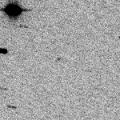
|
Return of a new periodic comet which brightened up to 17 mag in 2001. It was missed at the last return in 2010. Now it is 19.1 mag (Sept. 8, E. Schwab, D. Abreu). It was predicted to brighten up to 17.5 mag from September to November. But actually, it is a bit fainter than predicted.
Date(TT) R.A. (2000) Decl. Delta r Elong. m1 Best Time(A, h)
Oct. 20 1 46.95 -12 49.6 1.243 2.195 156 17.5 23:51 ( 0, 42)
Oct. 27 1 41.15 -12 2.7 1.258 2.198 154 17.6 23:18 ( 0, 43)
|
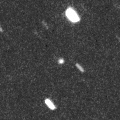
|
Now it is 17.6 mag (Sept. 13, iTelescope Observatory, Mayhill). It was observed at 18 mag in last winter. It will be observable in good condition at 17.5 mag also in this winter.
Date(TT) R.A. (2000) Decl. Delta r Elong. m1 Best Time(A, h)
Oct. 20 7 17.35 7 59.2 2.592 2.878 96 17.7 4:45 (339, 61)
Oct. 27 7 21.69 7 9.1 2.517 2.890 101 17.6 4:51 (354, 62)
|
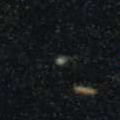
|
It brightened very rapidly. Now it is 17.3 mag (Sept. 16, Mt. Lemmon Survey). It will be fading after October.
Date(TT) R.A. (2000) Decl. Delta r Elong. m1 Best Time(A, h)
Oct. 20 23 53.16 -15 51.7 0.856 1.759 143 17.7 21:58 ( 0, 39)
Oct. 27 23 52.81 -14 26.2 0.896 1.763 137 17.8 21:30 ( 0, 41)
|
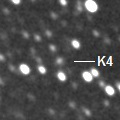
|
Now it is 17.7 mag (Oct. 1, Ken-ichi Kadota). It was observed at 16 mag from summer to autumn in 2017. It will be observable at 17 mag in good condition also in 2018. It locates somewhat low in the Southern Hemisphere.
Date(TT) R.A. (2000) Decl. Delta r Elong. m1 Best Time(A, h)
Oct. 20 0 42.92 28 54.3 2.879 3.817 157 17.7 22:47 ( 0, 84)
Oct. 27 0 39.43 28 21.1 2.941 3.863 154 17.8 22:16 ( 0, 83)
|

|
Now it is 17.8 mag (Aug. 23, iTelescope Observatory, Siding Spring). It stays 17 mag in 2018.
Date(TT) R.A. (2000) Decl. Delta r Elong. m1 Best Time(A, h)
Oct. 20 5 12.92 2 37.3 7.119 7.747 126 17.8 3:21 ( 0, 58)
Oct. 27 5 11.74 2 20.6 7.075 7.781 132 17.8 2:52 ( 0, 57)
|
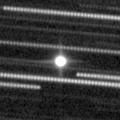
|
Although it is around the aphelion, it is observable at 17.5 mag in November, in good condition in the Northern Hemisphere. It locates very low in the Southern Hemisphere.
Date(TT) R.A. (2000) Decl. Delta r Elong. m1 Best Time(A, h)
Oct. 20 3 56.59 41 17.6 1.581 2.402 136 18.1 2:05 (180, 84)
Oct. 27 3 41.27 41 8.5 1.520 2.399 144 17.9 1:23 (180, 84)
|
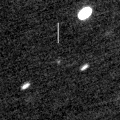
|
Now it is 18.5 mag (Sept. 12, D. Buczynski). It is observable at 17.5 mag until January, in good condition in the Northern Hemisphere. It locates very low in the Southern Hemisphere.
Date(TT) R.A. (2000) Decl. Delta r Elong. m1 Best Time(A, h)
Oct. 20 6 36.04 36 3.0 3.284 3.720 108 18.0 4:44 (180, 89)
Oct. 27 6 37.83 36 51.3 3.202 3.729 114 17.9 4:18 (180, 88)
|
|
![]()
 29P/Schwassmann-Wachmann 1
29P/Schwassmann-Wachmann 1 78P/Gehrels 2
78P/Gehrels 2 C/2017 T3 ( ATLAS )
C/2017 T3 ( ATLAS ) 48P/Johnson
48P/Johnson C/2018 N2 ( ASASSN )
C/2018 N2 ( ASASSN ) C/2017 S3 ( PanSTARRS )
C/2017 S3 ( PanSTARRS ) C/2017 M4 ( ATLAS )
C/2017 M4 ( ATLAS ) C/2015 O1 ( PanSTARRS )
C/2015 O1 ( PanSTARRS ) (944) Hidalgo
(944) Hidalgo C/2018 N1 ( NEOWISE )
C/2018 N1 ( NEOWISE ) 300P/Catalina
300P/Catalina C/2017 B3 ( LINEAR )
C/2017 B3 ( LINEAR ) 123P/West-Hartley
123P/West-Hartley C/2018 A3 ( ATLAS )
C/2018 A3 ( ATLAS ) C/2017 T2 ( PanSTARRS )
C/2017 T2 ( PanSTARRS ) C/2015 V2 ( Johnson )
C/2015 V2 ( Johnson ) 65P/Gunn
65P/Gunn C/2016 A1 ( PanSTARRS )
C/2016 A1 ( PanSTARRS ) 60P/Tsuchinshan 2
60P/Tsuchinshan 2 (3552) Don Quixote
(3552) Don Quixote 37P/Forbes
37P/Forbes 171P/Spahr
171P/Spahr 59P/Kearns-Kwee
59P/Kearns-Kwee C/2010 U3 ( Boattini )
C/2010 U3 ( Boattini ) 369P/2018 P1 ( Hill )
369P/2018 P1 ( Hill ) A/2017 U7
A/2017 U7 368P/2018 L3 ( NEAT )
368P/2018 L3 ( NEAT ) C/2015 V1 ( PanSTARRS )
C/2015 V1 ( PanSTARRS ) 164P/Christensen
164P/Christensen 137P/Shoemaker-Levy 2
137P/Shoemaker-Levy 2 C/2014 OE4 ( PanSTARRS )
C/2014 OE4 ( PanSTARRS ) C/2015 XY1 ( Lemmon )
C/2015 XY1 ( Lemmon ) 240P/NEAT
240P/NEAT 371P/2018 R1 ( LINEAR-Skiff )
371P/2018 R1 ( LINEAR-Skiff ) 361P/2017 S4 ( Spacewatch )
361P/2017 S4 ( Spacewatch ) P/2018 P3 ( PanSTARRS )
P/2018 P3 ( PanSTARRS ) C/2017 K4 ( ATLAS )
C/2017 K4 ( ATLAS ) C/2011 KP36 ( Spacewatch )
C/2011 KP36 ( Spacewatch ) (3200) Phaethon
(3200) Phaethon 159P/LONEOS
159P/LONEOS![]()













































